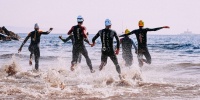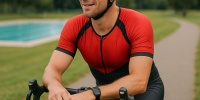Top Breathing Techniques for Triathletes: Enhance Your Performance
Par Sarah Publié le 19/10/2025 à 20h01 — modifié le 18/10/2025 à 20h01 Temps de lecture : 3 minutes Crédit Image: Alex P
Crédit Image: Alex P
Understanding Breathing for Endurance Athletes
For triathletes, mastering breathing isn't merely a supportive function—it's essential for optimizing performance during each segment of the race. Whether you’re swimming, cycling, or running, effective breathing techniques can help enhance stamina, and control anxiety, and maximize oxygen intake.
What Are Breathing Exercises?
Breathing exercises are techniques developed to improve lung capacity, strengthen respiratory muscles, and enhance overall control of your breath. For triathletes, these exercises are crucial to increase efficiency, particularly in high-endurance situations that challenge both body and mind.
Heart Coherence
Heart coherence is a state in which your heart, mind, and emotions are aligned and working together. This alignment can significantly impact your performance, particularly under the stress of competition.
- How It Works: When your heart rate variability is optimal, it allows for effective oxygen distribution throughout the body. This can enhance endurance and lower stress levels.
- Practicing Heart Coherence: One common method is the HeartMath technique, which includes slowing your breathing down to five seconds on inhalation and five seconds on exhalation while focusing on positive emotions.
Diaphragmatic Breathing
Diaphragmatic breathing, or belly breathing, utilizes the diaphragm effectively, allowing for greater oxygen intake and efficiency during exertion.
- Why It Matters: Many athletes unconsciously engage in shallow chest breathing, which can limit lung capacity. In contrast, diaphragmatic breathing promotes full inhalation, improving oxygen uptake.
- How to Perform: To practice, lie down or sit in a comfortable position. Place one hand on your chest and the other on your abdomen. Breathe in through your nose deeply enough that your stomach rises while limiting any significant movement in your chest. Exhale slowly through your mouth.
Apnea Training
Apnea training includes static or dynamic breath-holding exercises. It can bolster your ability to tolerate higher levels of carbon dioxide and build lung capacity.
- Why It’s Beneficial: Apnea training enhances your ability to manage breath under exertion, reducing the perception of fatigue and improving performance during the swimming and running sections of triathlons.
- How to Get Started: Start with simple static breath-holding exercises. Take a deep breath in and hold for as long as you can. Repeat this several times while ensuring you remain relaxed and calm.
Key Metrics for Measuring Breathing Effectiveness
When incorporating breathing exercises into your training, tracking certain metrics can help evaluate their effectiveness:
- Ventilatory Threshold (VT): Determine the intensity at which your breathing starts to increase disproportionately compared to heart rate.
- Lung Function Tests: Use tests such as spirometry to measure lung capacity and function over time.
- Heart Rate Variability (HRV): Monitor your HRV during and after training sessions to understand how breathing exercises improve your autonomic nervous system regulation.
Concrete Benefits of Breathing Exercises for Triathletes
Several research studies highlight that effective breathing techniques can significantly enhance athletic performance. According to a study published in the Journal of Sports Sciences, athletes who practiced diaphragmatic breathing techniques showed marked improvements in VO2 max and performance metrics during endurance activities.
Benefits Include:
- Improved Endurance: Greater oxygen flow provides your muscles with the energy needed to perform longer and more intensely.
- Enhanced Recovery: Focused breathing techniques during rest can speed up recovery times by facilitating better oxygenation and waste removal from muscles.
- Reduced Anxiety: Increased confidence arises from being in control of your breathing, allowing you to maintain calmness before and during races.
Integrating Breathing Techniques into Your Training Regime
Effectively incorporating these breathing techniques into your training requires a strategic approach:
- Plan Sessions: Dedicate specific training sessions to focus solely on breathing techniques. This helps in developing comfort with each technique.
- Combine with Physical Training: During workouts, integrate these breathing exercises, particularly during high-intensity segments, to practice applying these methods in real-time.
- Track Progress: Log how you feel during and after workouts, and remain attentive to improvements in endurance and speed.
- Stay Consistent: Like any training technique, consistency is crucial. Aim for short, daily practices rather than long, sporadic sessions.
Considerations and Precautions
While breathing exercises can yield substantial benefits, it’s vital to remain cautious:
- Consult Professionals: If you're new to these techniques or have preexisting health conditions, consider consulting a sports physician or breathing coach.
- Begin Gradually: Start with shorter durations for breath-holding and increase gradually to avoid feelings of distress or dizziness.
- Stay Mindful: Pay attention to what feels right for your body. If you experience discomfort, modify or halt the practice.
Conclusion
Empowering your performance as a triathlete is possible through the implementation of effective breathing exercises. By mastering heart coherence, diaphragmatic training, and apnea practices, you'll not only enhance your physical capabilities but also secure mental clarity and reduce stress. As you commit to a journey of continuous improvement, these breathing techniques can transform the way you approach your training and performance outcomes!
🧠 FAQ - Best Breathing Exercises for Triathletes
❓ What are the best breathing exercises for triathletes?
The best breathing exercises for triathletes include heart coherence, diaphragmatic training, and apnea techniques to improve lung capacity and performance.
❓ How do breathing exercises help triathletes?
Breathing exercises help improve oxygen intake, enhance endurance, reduce anxiety, and promote faster recovery during and after races.
❓ How often should I practice breathing exercises?
Consistency is key; aim for daily practice sessions of breathing techniques, integrating them into your training regime to see optimal benefits.
❓ Can these exercises reduce anxiety during races?
Yes, practicing controlled breathing techniques can help calm nerves and anxiety, allowing for better focus and performance during competition.
❓ Is there any scientific evidence supporting breathing exercises?
Yes, studies, such as those published in the Journal of Sports Sciences, show that breathing techniques can improve VO2 max and endurance performance.
❓ Should beginners consult professionals before starting?
It’s advisable for beginners to consult professionals or coaches when starting breathing exercises, especially if they have underlying health concerns.

Les fondamentaux d'un plan d'entrainement en Triathlon






